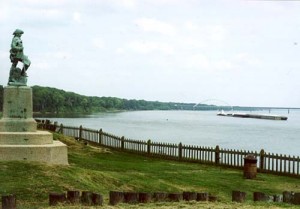The Great Anti-Climax
It was the moment Aaron Burr had been working toward for two years. In late December, 1806, he stood on the Illinois shore of the Ohio River, just below the mouth of the Cumberland River. Gathered around him were the men who had volunteered to join his expedition to liberate the Spanish lands of Florida, Texas, Mexico, and who knew what else — perhaps Louisiana and America’s Western lands would join in Burr’s bold new venture?
Some of the men who faced the former vice president were rugged frontier types and able river pilots. Others were bored schoolteachers and dancing masters. All had been lured by Burr’s promises of riches and adventure. They were the material with which Burr and his principal ally, American Army General-in-Chief James Wilkinson, hoped to change history.

View of the Ohio River from Fort Massac State Park in Illinois, close to where Aaron Burr first addressed his adventurers in December 1806. The statue is of George Rogers Clark, not Burr.
But there were so few of them. Burr had commissioned the building of enough boats to transport 1500 men down the Ohio and Mississippi Rivers to New Orleans. At a time when the entire U.S. Army numbered 3,300, it would have been an immensely powerful force.
But because of sensational reports of his true aims, as well as a Kentucky prosecutor’s attempt to throw Burr himself into jail, popular support for the expedition had fizzled. No more than 100 men surrounded him. Burr had to hope that Wilkinson would swell their ranks on the lower Mississippi with a large group of soldiers.
After greeting each of the adventurers personally, Burr mounted a small rise to address his band. They waited expectantly for inspiring words from the great man before them, who had almost been elected president of the United States just six years before. The moment was charged with electricity.
Burr noticed that local residents had come down to the riverside to see and hear him. For frontier residents, the arrival of a group of 100 men, led by the former vice president, was a major event. Burr, a man who dreamt huge dreams, suddenly had a fit of caution. He did not want to say something unwise, something that might be used against him, in front of people who were not part of his expedition.
So Burr made a short statement that had to be deflating. According to several men who were there, he pointed to the bystanders and said he could not speak of the expedition’s true destination. The men could ask their captains where they were headed. And then he stopped. The men boarded their boats and headed downriver.
Almost a year later, when Burr was facing criminal charges growing out of the expedition, Chief Justice John Marshall zeroed in on that moment on the Ohio River shore. If Burr’s intentions were innocent, Marshall stressed, he surely could have told his men where they were headed and what his plan was.
But he didn’t.